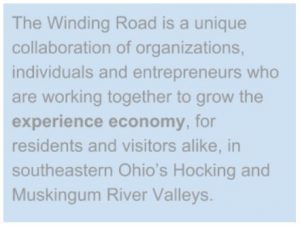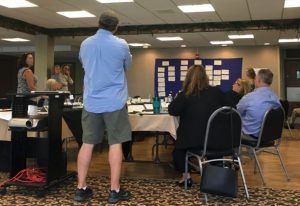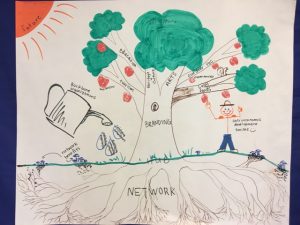
When we met John Winnenburg, at the Appalachian Studies Association conference last year, the Winding Road initiative was in transition.
“We started out with a participatory vision, but then, politics and personalities started to dominate. We weren’t creating the right conditions for the cross-sector collaboration and leadership we needed, and people were dropping off. I was working to recapture the momentum and participatory nature of the initiative,” says John.
“About that time I went to the conference and attended Tracy and Michelle’s ‘Consent-based Decision-making’ session. After the session I thought, ‘This is just what we’ve been needing!'”
The Vision of “Ohio’s Rising Appalachia”
John, in his role on the Board of the Ohio Hill Country Heritage Area (OHCHA), for years had been a champion of building an economy around SE Ohio’s rich history, locally produced food, unique dining and lodging experiences, exceptional arts and crafts, gorgeous national forest, and spreading trail system for hiking, biking, and outdoor adventure. By communicating the value of this natural and cultural wealth through shared branding, and by helping entrepreneurs develop products and experiences to develop those new markets, they hoped to generate what some call an “experience economy, or “place-based development.”

Governance that’s Bigger than Any One Organization
John and his fellow members of the OHCHA Board could sense that the Winding Road was a bigger vision than any one organization could hold. They knew they needed a multi-stakeholder partnership to make real strides in this region-wide economic development initiative. But after their initial experiences, they realized they didn’t yet have a workable framework for how partner organizations, entrepreneurs and funders could authentically develop and steer in a collaborative way toward that vision.
A regional economy is a complex system with many interdependent players. David Renz, in his groundbreaking Nonprofit Quarterly article Reframing Governance II, writes,
“In many of the settings where we address our most complex and demanding community needs,…the scale of these problems has outgrown the capacity of our existing freestanding organizations to respond—sometimes in terms of size, but especially, and more important, in terms of complexity and dynamism.”
“Therefore, we’ve organized or developed our response at yet another level: the inter-organizational alliance. In the new mode, the organization may well be the unit from which services are delivered, but such service delivery is designed, organized, resourced, and coordinated (in other words, governed) by the overarching network of relationships (among organizational leaders) that crosses and links all participating organizations and entities.”
Steering a change at this level requires the participation of all the different parts of the system – nonprofit, government, business, academia, and funders – working together to align their efforts toward a shared “North Star.” Working across organizations and at different scales means that communications, processes, and decision-making have to bridge at least 3 levels of complexity.*
- Institutional complexity – economic systems cut across the traditional jurisdictions of government (local, regional, national), the programs of different organizations, and the boundaries between the public, private, and societal domains.
- Substantive complexity – all the different systems actors have their own perceptions of the nature of problems, causes and solutions.
- Strategic complexity – a large variety of strategies are at play, and systems actors interact with and respond to each other’s strategies in ways that are ever-changing and often unexpected.
This creates a great deal of uncertainty about how to handle collaborative processes and what rules will guide interactions with others.
Collaborative Governance via a Network Structure and Decision-making by Consent
One of the first steps that Circle Forward Partners advised was for the board of OHCHA to invite other organizations into a leadership group that could guide the development of a network of partnerships. Now instead of stewarding The Winding Road as its own “program,” OHCHA is one organization within a Coordinating Group of stakeholders.
These leaders are very clear that while they are creating enough structure to stay organized, they are not starting a new organization. They’re using a network structure to allow the intiative to function more like an ecosystem of interrelated actors, where organizations find their roles or niches, and align their efforts in a larger whole. They are learning about each other’s work and filling gaps. The Coordinating Group also adopted a Consent-based model for governance decision-making to balance power and support equity, diversity and inclusion.
In Networked Governance: Gaining New Insights into This Unique Approach to Leadership, David Renz cites research on important principles for multi-stakeholder partnerships, including these two:
- It is important to use inclusive processes to develop inclusive structures, which in turn will (and will need to) sustain inclusive processes.
- It is important to adopt flexible governance structures that can adjust to requirements that will change throughout the life cycle of the collaboration.
Many of the participants in the Winding Road network are finding this to be consistent with their experience.
Deepening the Investment in the Work

Photo of Coordinating Group Retreat courtesy of Madelyn Brewer, Special Projects Coordinator, ACEnet
The Coordinating Group had been meeting via teleconference until the end of August 2018, when Tracy facilitated a 1 1/2 day retreat for this Coordinating Group. It was the first time the initiating partners had been all together in one room for planning. They identified their shared measures of success, as well as adaptive plans for action and working groups to help get them there.
Over the next several months, Circle Forward Partners will be supporting the development of their governance documents, agreements, and policies. We will also be on board as they address 8 fundamental Governance Design Issues for network governance, with the Principle of Consent as the basis for decision-making.
Today John reports,
In one of the retreat exercises, participants drew pictures as metaphors for the change process and strategy.
“I’m really excited. I continue to feel a little overwhelmed but I’m feeling like I’m not alone in the process any more, carrying the heavy load. Especially since the retreat it seems like the other stakeholders are ready to start participating in an active way. “
“One thing we really value about Tracy’s facilitation is being able to embrace the confusion instead of fearing it. Tracy’s facilitation has given us some confidence that the confusion is leading us somewhere meaningful. Also, her supportive feedback on a regular basis has been really critical. It has deepened people’s investment in the network and the work.”
We can’t wait to see where their journey takes them next!
* Klijn, Erik Hans; Koppenjan, Joop, 2016. Governance Networks in the Public Sector. Taylor and Francis. Kindle Edition.


